
Original Link: https://www.anandtech.com/show/2246
AMD Athlon X2 BE-2350: Mainstream X2s with 45W TDP
by Anand Lal Shimpi on June 5, 2007 4:09 PM EST- Posted in
- CPUs
Those hoping for nail biting, teeth clenching battles should apply elsewhere - the CPU war these days is a one horse race. If reports out of Taiwan are to be believed, initial performance results from AMD's Barcelona fail to impress and we've got at least a quarter before the race can even potentially get competitive. But as we've seen lately, you don't need chart topping performance to bring excitement to the game.
By aggressively cutting prices, AMD actually made most of its product lineup below $300 competitive with equivalently priced Intel offerings. Granted that AMD won't be making a tremendous amount of money by doing this, but the end user stands to benefit, especially those with Socket-AM2 motherboards looking for faster CPUs.
Today AMD follows with yet another affordable CPU introduction; priced at $91 and $86 respectively, the Athlon X2 BE-2350 and 2300 aren't designed to take the performance crown from Intel, but rather they are decent dual core performers with a mere 45W TDP.
These two 65nm processors run at 2.1GHz and 1.9GHz, and are architecturally no different than the Athlon 64 X2s we've been reviewing for a while now. Carefully selected as chips that can run at lower operating voltages and thus lower TDPs, these two processors are designed to be a more available version of the Energy Efficient Small Form Factor X2s that were introduced last year. While they have a higher TDP than the 35W Athlon 64 X2 3800+, AMD insists that availability of these 45W parts won't be a problem. At the time of publication we couldn't confirm AMD's claims, so we'll just have to wait and see. Prior to today's introduction, the lowest TDP widely available from an X2 was 65W, so the release of 45W parts is designed to fill a gap in AMD's product lineup.
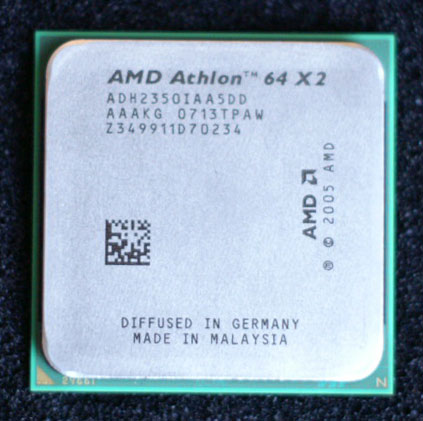
At the price points AMD is targeting with the BE-2350 and 2300, Intel doesn't really have a good competitor. While you can get older Pentium 4s for less than $100, you wouldn't really want to from a power and performance standpoint. The closest Intel has to offer is the Core 2 Duo E4300, which we've been able to find online for $113.50, thus making it the best competition we can find. Note that both of these chips are more expensive than the X2 3800+, currently priced at $83 and running at 2.0GHz. The slight premium comes from the lower yield on these chips, and resultant lower TDP.
Keep in mind that Intel's closest competition is more expensive throughout the course of this review, because after AMD's latest price cuts you can truly get some powerful CPUs for less than $100.
Eeech, Model Numbers
Although all current AMD processors retain their original names, the two being introduced today are the first to use AMD's new model numbers. As announced during its Phenom introduction, AMD is dropping the 64 from its product names - the new chips are simply Athlon X2s. The 64-bit race is over now that both AMD and Intel have 64-bit support on a majority of their processors, and now it's time to move on. All previous X2s will still be called Athlon 64 X2s and AMD isn't changing the logo just yet, but eventually it will phase out the old names/model numbers in favor of the new system.

What exactly is the new system? It's a slightly more complicated version of Intel's model number system. Here's the explanation of the new system straight from AMD:
The introduction of the AMD AthlonTM X2 dual core processor BE-2350 and BE-2300 brings the first opportunity to learn about AMD's new model methodology. The goal with the new system was to better inform processor choice and utilize a methodology that be long lasting. Existing products will retain their current model numbers. Our customers are familiar with the current models and we will continue to utilize that system until it is phased out over a period of time by new product introductions.
Let's look at a sample model number: BE-2350 (This is the AMD Athlon X2 dual-core 45-watt desktop CPU you have for review)
Format:
The new AMD desktop processor models have an alpha numeric format of A A - # # # #.
First two characters: BE-2350
The first and second alpha indicate the processor class. The second alpha character indicates the TDP of the processor. The "BE" class is comprised of sub-65W processors. This chip's TDP is 45 watts. As additional products are introduced, new classes will also be introduced and these new classes will distinguish between key attributes of the processors.
First numeric digit: BE-2350
The first numeric digit after the dash is the processor series and indicates reflects major increments in processor attributes. The "2XXX" series is currently contained within the AMD Athlon X2 family of processors.
Note that we have dropped the "64" from the Athlon X2 name. AMD pioneered simultaneous 64/32-bit x86 processing. Now that 64-bit processing is ubiquitous and AMD is recognized for its leadership, maintaining a "64" in our desktop product naming methodology is not necessary, and the shortened name simplifies product references.
Last three numeric digits: BE-2350
The last three numeric digits after the dash indicate the relative position of the CPU within its class series. Increasing numbers within a class series indicates increments in processor attributes.
In summary:
Please note that the actual assignment of letters and numbers are intentionally arbitrary, but these digits are combined in such a way as to avoid confusion between models while indicating major and minor processor increments. Just by reading the "BE-2350" model number, you know that it is a mainstream desktop CPU. You know its power consumption level is below 65 watts. You know that it is in the Athlon X2 family. And you know its position relative to other CPUs. As new processors are introduced, the combination of class and models should be of increasing value in identifying and distinguishing AMD processors. Previously, our model numbers indicated relative performance but were unable to capture the step function performance multi-core processors in many usage scenarios and were unable to capture additional processor features or attributes.
Normally we don't quote manufacturer emails to us verbatim, but this one just seemed so appropriate. To break it down for you, we'll compare AMD's new naming scheme to Intel's.
The first letter in Intel's naming system indicates processor class, for example the E6600 vs. X6800. With AMD's new system, we have two letters that describe the class, with the second one being used to indicate TDP. The following four digits in Intel's system simply indicate performance of the processor relative to others in its class; e.g. an E6600 is faster than an E6320, the first digit indicating major performance differences between chips (e.g. E6600 has 4MB L2 cache 1066MHz FSB, while the E4300 has a 2MB L2 cache and 800MHz FSB). AMD's system is similar, the first digit is reserved for major differences in performance, while the latter three digits are used for minor differences (think speed bins).
All in all, AMD's system is a response to Intel's system, neither of which is perfect. We liked Intel's naming system on the Core 2 lineup back when it was simple and each model was separated by increments of 100. The introduction of the E6420 and E6320 made the system a bit more messy and the upcoming 1333MHz FSB CPUs will only further complicate the lineup. AMD appears to be starting in a period of disarray and if recent articles on the forthcoming lineup are correct, we'll absolutely hate talking about CPUs from both manufacturers.
The Test
Note that SYSMark 2007 only runs on 32-bit versions of Windows, so all of the tests for this article were conducted under Windows Vista Ultimate 32-bit.
| CPU: | AMD Athlon 64 X2 3800+ (2.0GHz/512KBx2) AMD Athlon X2 BE-2350 (2.1GHz/512KBx2) AMD Athlon X2 BE-2300 (1.9GHz/512KBx2) Intel Core 2 Duo E6320 (1.86GHz/4MB) Intel Core 2 Duo E4300 (1.80GHz/2MB) |
| Motherboard: | ASUS P5B Deluxe (P965) ASUS M2N32-SLI Deluxe (nForce 590 SLI) |
| Chipset: | Intel P965 NVIDIA nForce 590 SLI |
| Chipset Drivers: | Intel 8.1.1.1010 (Intel) Integrated Vista Drivers (NVIDIA) |
| Hard Disk: | Seagate 7200.9 300GB SATA |
| Memory: | Corsair XMS2 DDR2-800 4-4-4-12 (1GB x 2) |
| Video Card: | NVIDIA GeForce 8800 GTX |
| Video Drivers: | NVIDIA ForceWare 158.18 |
| Desktop Resolution: | 1600 x 1200 |
| OS: | Windows Vista Ultimate 32-bit |
General Performance
After years of waiting we can finally move away from SYSMark 2004 as BAPCo has just released SYSMark 2007, its latest benchmark suite that boasts full Vista compatibility (only 32-bit however). As always, SYSMark is divided into a number of individual performance categories, which together provide an overall performance score for the system.
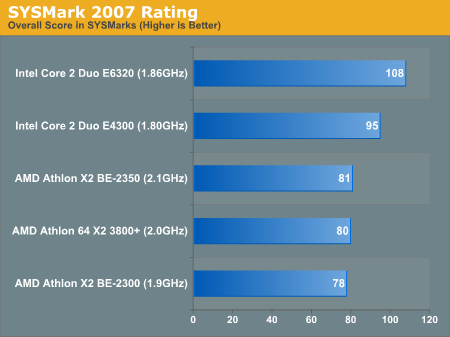
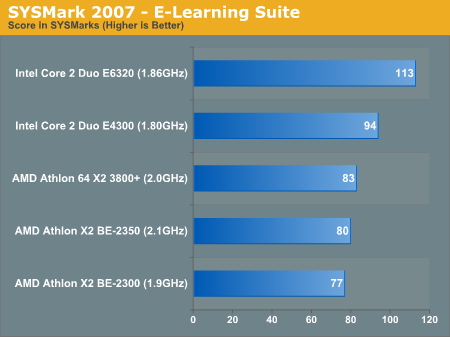
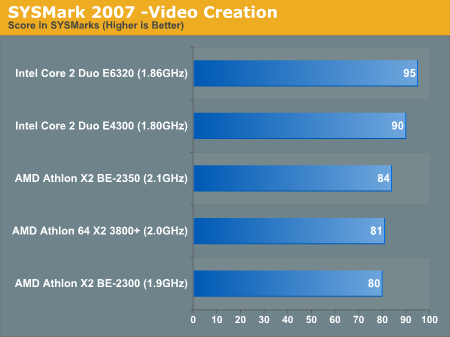
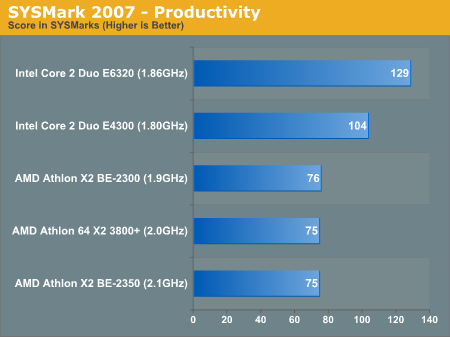
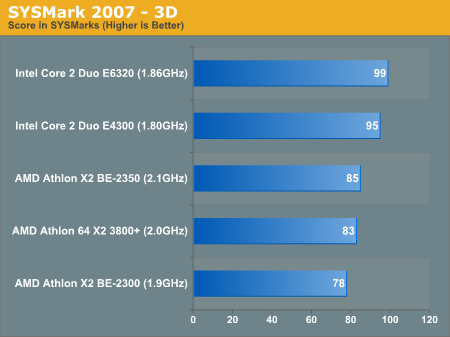
Media Encoding Performance
We've moved to DivX 6.6 but our test settings remain the same. We use the codec in its unconstrained profile, using a quality present of 5 in 1-pass mode. Enhanced multithreading is enabled and we report encoding frame rate for our 1080p source file.
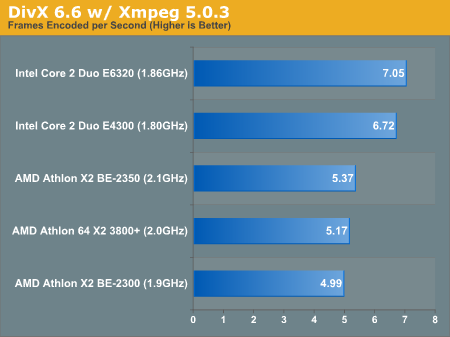
Our WME9 test remains the same as we've run it in the past; performance is reported in frames encoded per second:

We also looked at encode time using Windows Movie Maker, an application that comes with Windows Vista. We measured the time it took to encode content recorded off of Media Center into a format for posting on YouTube. Encode time was measured in seconds:
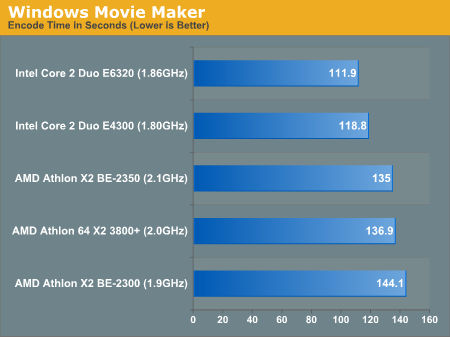
We conclude our look at Media Encoding performance with a simple conversion from a 304MB wav file to a 192kbps MP3 using iTunes. The conversion rate is reported in MB/s:

3D Rendering Performance
Our 3dsmax 9 test scenario is still made up of the CPU rendering tests of the SPECapc 3dsmax benchmark. We report the rendering composite, which is simply the geometric mean of render times across seven benchmarks normalized to a set of reference scores.
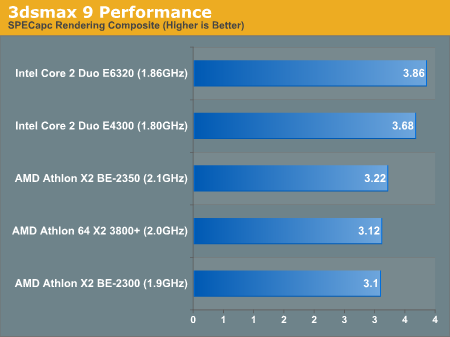
POV-Ray's ray tracing benchmark has been a popular CPU test for quite some time, and we turn to its SMP beta to stress the CPUs here today (we use the sse2 binary):
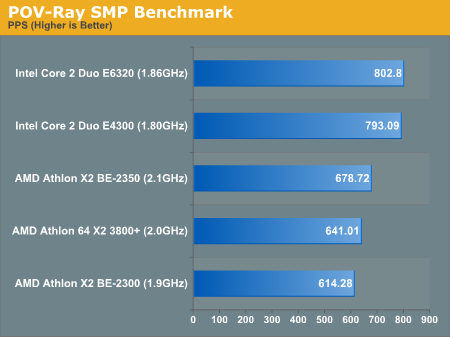
Our final 3D benchmark is the 32-bit version of Cinebench 9.5, a fairly popular 3D rendering benchmark due to its ease of use and quick runtimes. We ran the multi-threaded CPU rendering test and reported the final score in CBmarks. Higher numbers are better:

Photo Processing Performance
We turned to the Retouch Artists Photoshop Speed Test for measuring CPU performance in Adobe's Photoshop CS3 beta. The benchmark applies a number of actions to a test image while we measure the total time elapsed during the active portion of the test. We report results in seconds, with lower scores denoting higher performance.
We set history states to 1 and cache levels to 4; CS3 was configured to make use of all available system memory.
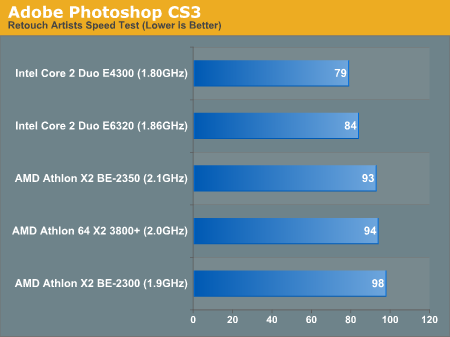
Gaming Performance

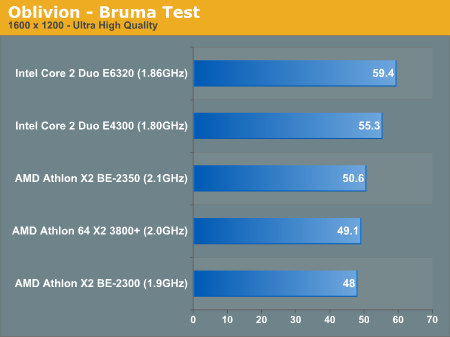
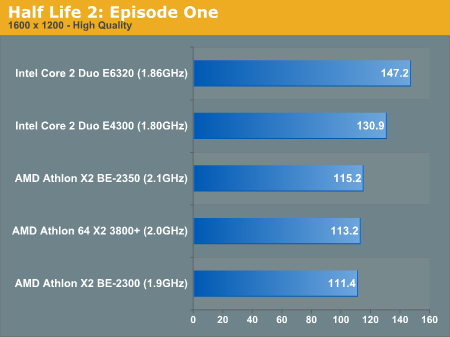
Power Consumption
Where possible we used the same components between our two test beds to level the playing field for measuring power consumption (both EIST and CnQ were enabled), however with different chipsets making up our CPU test beds it's difficult to compare AMD to Intel here. That being said, you can get a good idea of how the new 45W AMD CPUs stack up to their 65W brothers and the older 35W X2 if you were so lucky as to buy one:
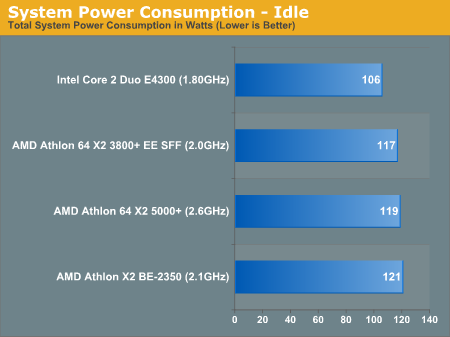

Final Words
The performance of the Athlon X2 BE-23xx lineup isn't particularly impressive, but that is to be expected. Power consumption is definitely down over the standard 65nm 65W Athlon 64 X2s, but not as low as the old 35W EE SFF parts were. A direct comparison to the Core 2 Duo E4300 is difficult given that we are forced to use different chipsets/motherboards, but for a high performance system you can easily build a comparably low power system out of Intel parts. AMD argues that with integrated graphics you can deliver a lower overall TDP on one of its systems, which we tend to believe given that the P965 is one of the lowest power Intel chipsets you can buy whereas the nForce 590 SLI that's a part of our normal AMD test bed is far from the lowest power offering out there. We will be looking at integrated graphics/platform performance in a future CPU article when we will address this topic in greater detail.
If you're simply looking for a high performance system with lower power requirements, possibly just to keep your office/room cooler and quieter, then the Core 2 Duo E4300 is still a better bet than either of these new X2s. You will pay about $25 more, but the increase in performance is more than tangible (not to mention the fact that you can actually get close to top of the line performance if you decide to overclock the E4300).
However, if performance isn't a primary concern and you're not interested in overclocking (our BE-2350 wouldn't even break 2.4GHz), then these chips offer an interesting alternative to current 65W X2s. The only issue is that you have to be committed to AMD's Socket-AM2 platform, which at this point we're not sure will give you a good upgrade path in the future (depending on how successful Phenom ends up being).







